Below is a description of all the cases relating to the flap for insufficient material (to see all the other types of flaps,
click here ).
Case A: A PLAYER WAS OUT OF TIME BUT THE MATCH IS AWARDED
Obviously, the player who finishes his time first loses the game, but there are exceptions where the game is still closed as DRAW.
The sense of this rule contained in the chess rules is that the victory is not assigned, but it's only assigned the draw, to who, despite having theoretically won by time, does not have enough material to checkmate.
In fact, in the following cases, the player who" would have" won for the time CANNOT GIVE AWAY EVEN IF THE OPPONENT COLLABORATES by playing the worst moves to his own detriment.
In fact, in the following cases, the player who "would" win for by time CANNOT CHECKMATE EVEN IF THE OPPONENT COLLABORATES by playing the worst moves of his own.
1) WITH THE KIND ONLY
The player who "would have" won by time has only the King (by far the most frequent case).
In this example, if White runs out of time, the game is drawn. Even when both players are left with the King only it is obviously an automatic draw.
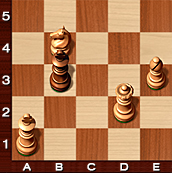
2) KING AND BISHOP VS KING
When a player has king and bishop and the opponent has only the king, neither player is able to checkmate.
Automatic draw.
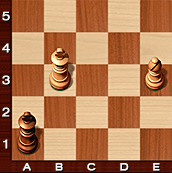
3) KING AND KNIGHT VS KING
When a player has a king and a knight and the opponent has only the king, neither player is able to checkmate.
Automatic flap.
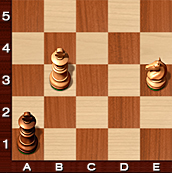
4) KING AND BISHOP VS KING AND BISHOP IN THE SAME SQUARE
Both players have kings and bishops moving onto squares of the same color.
In the absence of pawns it is not possible in any way to checkmate.
Automatic draw.
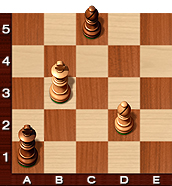
5) KING AND BISHOP VS KING AND ROOKS
King and bishop alone (unlike king and knight in case 13) are unable to checkmate when the opponent has king and rook.
Even in the most favorable position for Black, such as the one alongside, if White plays  b2, after
b2, after  xb2 we are in the draw situation described in case 2.
xb2 we are in the draw situation described in case 2.
Of course it is a draw case only if the player with the rook runs out of time.
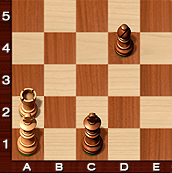
6) KING AND BISHOP against KING AND QUEEN
Even more so the king and bishop are unable to checkmate when the opponent has the queen.
In the example on the side, on 1… d4+ follows 2.
d4+ follows 2. b2+ and the game is draw (obviously only if it is White who runs out of time).
b2+ and the game is draw (obviously only if it is White who runs out of time).
Paradoxically, in this example, if White has, in addition to the queen, a bishop on white squares, a knight or a pawn then he loses
(if he runs out of time) because it is possible to build a helpmate.
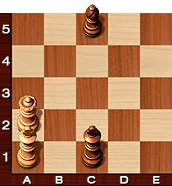
7) KING AND KNIGHT VS KING AND QUEEN
King and knight are able to win against kings and rooks, but not king and queen.
In the example beside, even if White runs out of time the game is drawn. Not even in the most favorable case the Black could make checkmate. For example on 1… c2+ White gives the Woman with
c2+ White gives the Woman with  xc2.
xc2.
If, however, in addition to the queen, White has a pawn or any other piece, which is not a second queen, he loses (if he has run out of time) because it is possible to build a helpmate.

Case B: THEORETICAL BUT NOT PRACTICAL DRAW CASES
A player loses by time although the game should be considered a draw case because the opponent does not have enough pieces to checkmate.
9) The draw case #4 seen above assumes the bishops on squares of the same color. If, on the other hand, the bishops are of the opposite color, it is possible to checkmate if one of the two players makes a mistake.
In the example opposite, Black has just played 1… b1?? followed by 2.
b1?? followed by 2. d4 checkmate. So the player who runs out of time loses, as the opponent may be able to mate him.
d4 checkmate. So the player who runs out of time loses, as the opponent may be able to mate him.

10) Even with knight against knight it is possible to checkmate if one of the two players makes a mistake.
Here Black made a mistake by playing 1… b1?? followed by 2.
b1?? followed by 2. c2 checkmate. So the player who runs out of time loses, as the opponent may be able to checkmate. The presence of additional pieces does not affect the rule set out here.
c2 checkmate. So the player who runs out of time loses, as the opponent may be able to checkmate. The presence of additional pieces does not affect the rule set out here.
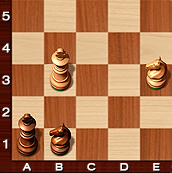
11) Even with Bishop against Knight it is possible to win.
Here Black played1… b1?? follows 2.
b1?? follows 2. b2 checkmate.
b2 checkmate.
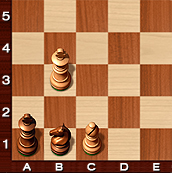
12) The same goes for the horse against the bishop: in the side position, with the white stroke follows
1. b3
b3 checkmate.
So the player who runs out of time loses, as the opponent may be able to checkmate him.
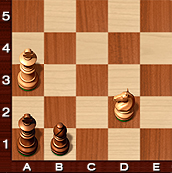
13) Even with knight vs rook it is possible to checkmate: here White played
1. a2??
a2?? followed by
1… b3
b3 checkmate.
So the player who runs out of time loses, as the opponent may be able to checkmate.
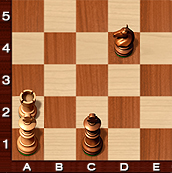
OTHER CASES
There are some cases that sometimes generate doubts that it is good to clarify:
14) In this position if White runs out of time obviously the victory goes to Black (who can promote to queen and win easily).
If, on the other hand, Black runs out of time, he cannot claim a draw, as by mistake he could, for example, promote his pawn to a knight, then move to bring this knight to b1 to checkmate with  b2! (see case 11 described above).
b2! (see case 11 described above).
So in this case, whoever runs out of time gets defeat.
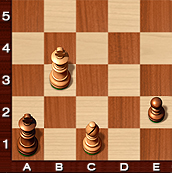
15) In this position, if White captures the pawn, the draw is immediate (see case 3 described above), but if black has time advantage, it is his right to try to win by time by moving back and forth without capturing the pawn, and avoiding the triple repetition of position.
You can speculate on time! The risk is of course that White finishes the time first, in which case the victory would go to Black.
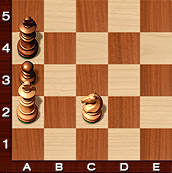
16) Even here those who run out of time lose!
Black cannot claim the draw (on the basis that White has only one bishop) because there is a way for him to lose! How?
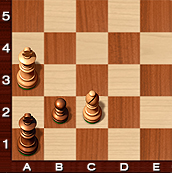
Promoting his pawn on knight (the only mistake he loses: other promotions fall within the draw cases seen at the beginning); then, like case 11 described above, Black brings the King to h1 and the Knight to g1 allowing  g2 checkmate.
g2 checkmate.
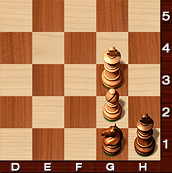
It is not unsportsmanlike to try to win for time!
Time is a fundamental component in blitz games (not to mention bullet games!), therefore the behavior of those who try to win by time in clearly drawn positions are legitimate. They can appear unsportsmanlike to those who are not used to the rigors of the blitz game: in reality there is no rule that prohibits them, and playing on time is also part of the ability to play fast.
On the other hand, those who prefer games in which time matters a little less, can launch challenges or make matches with an increase (i.e. where seconds are added to their time for each move made). The incremental cadences (for example 3 '+ 3 " instead of 5') with the initial 3 minutes plus the 3 seconds for each move made, make it practically impossible to lose for time in a clearly drawn position. They lose some of the thrill of the animated final game, but please those players who prefer more controlled rhythms.
